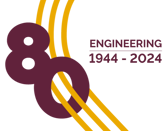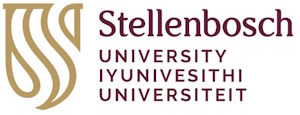
[Article by Corporate Communications]
The Faculty of Engineering recently hosted a trio of inaugural lecturers. Prof Thinus Booysen from the Department of Electrical and Electronic Engineering, Prof Richard Walls from the Fire Engineering Research Unit (FireSUN) in the Department of Civil Engineering and Prof Annie Bekker from the Department of Mechanical and Mechatronic Engineering captivated listeners with their respective presentations.
Prof Booysen’s lecture, “Engineering for Africa: Our Internet of Things” highlighted the innovative ways in which his research is improving the livelihoods of the poor and vulnerable, while, Prof Walls shared his ambitions to advance the fire safety of towns, homes, and informal settlements with his presentation, “Fire safety engineering – where physics and disasters meet.” Sharing her work on the SA Agulhas II, Prof Bekker’s session “What we can learn from the way a ship shudders on an icy wreck hunt” offered new insights into polar shipping,
In the following interviews Prof Booysen, Prof Walls and Prof Bekker discuss their research and passion for their fields.
| Prof Booysen’ s research improves livelihoods of the poor and vulnerable | Prof Walls helps to keep homes and informal settlements fire safe | Prof Annie Bekker undaunted by shuddering ships and icebergs |
|---|---|---|
| Tell us more about your research and why you became interested in this specific field.
My team and I conduct research on a variety of topics including water, energy, water and electricity costs at schools, minibus taxis, and computer vision. We have developed Internet-of-Things devices that have made a real difference in the lives of many people. The first is Geasy, our home-grown smart electric water heater controller, which remotely controls and monitors temperature, electricity, water, and a few other things. Its younger sibling, Count Dropula, does high resolution water metering. And there is Watts-on, which measures and reports electricity usage. We have also created a few other devices, such as a mobile phone-based spectrophotometer to measure water quality, a driving behaviour sensor, and quite a few mobility trackers. Through these and other research projects we aim to improve efficiency, reduce costs, and improve livelihoods – especially of the poor and vulnerable. As to why I became interested in this particular field of research, I would say my very short attention span, abundantly wide field of interest, desire to optimise, inherent control freakishness, and deeply rooted desire to understand things have been a perfect match for this field. How would you describe the relevance of your work? I use technology to bring about efficiency, cost reduction, improved custodianship of the environment, improved health, safety, and equity in various spheres of life. Can you tell us more about the social impact of your research? I realise we need research of all sorts and I only represent a small fraction of all of that, but for me personally, my research would be meaningless without social impact. I feel like I am wasting taxpayers’ money and urgent opportunities if I do not make the most of this amazing opportunity I have been given to find solutions to our many problems, and truth in our many uncertainties. My students know that this is the foundation and point of departure of our projects. To loosely quote the good book: show me research impact without social impact, and I will show you research impact through social impact. (Watch the inaugural lecture here.) |
Tell us more about your research and why you became interested in this specific field.
Our work focusses on fire safety engineering and structural fire design. Topics of research include informal settlement fire safety, structural fire design, materials at high temperature (i.e., what happens to materials as they get very hot and the bulk storage of agricultural or plastic materials). We try to understand what happens when a fire breaks out and how to mitigate the impacts of destructive fires. I got into the field by accident through my PhD supervisor, Dr Hennie de Clercq, who suggested a topic in structural fire engineering. I subsequently became very interested in the field in general. How would you describe the relevance of your work? Our work helps makes the world a safer place. It can help guide and promote the development of towns, plastic recycling facilities, high-rise buildings, wildland areas and agricultural facilities. Through developing practical solutions, we can keep towns, homes, petrochemical facilities, and informal homes fire safe. Can you tell us more about the social impact of your research? Our work has been extensively focussed on enhancing informal settlement fire safety and providing guidance for organisations working in such areas. The work has looked at understanding fire dynamics and spread between informal dwellings so that we can evaluate solutions to find what works, and what doesn’t. Also, work on structural fire engineering can help keep all types of buildings safe and can guide the repair of fire-damaged structures. Which aspects of your work do you enjoy the most? Burning things down during fire experiments, working with students and finding innovative ways to make the world safer. (Watch the inaugural lecture here.) |
Tell us more about your research and why you became interested in this specific field.
My research centres around the vibration of structures (cars, trucks, ships, etc) and I specifically enjoy test engineering where you can be at the coalface of the operational environment to stick your sensors. Knowledge of what is physically happening helps to interpret the data “squiggles” you see on graphs later. Right now, I want to reap novelty by feeding sensor data straight into engineering models, thereby providing decision-aiding information about operational asset through digital twin technologies. On the SA Agulhas II, we feed measurements about the torque (amount of twist) in the shaft into a model which calculates the torque that is applied at the propeller during an ice impact. By comparing this load from the impact to the design limit the crew can gain feedback if the ship is operating dangerously close to her design limit. My father, a mechanical engineer, drove us to school in the mornings. This drive was more like a vehicle performance test which intoxicated me and my brothers with a passion for cars and vehicle dynamics. Both my brothers and I are mechanical engineers today! My mother and I practiced music in the evenings – she on piano and me on violin. We would have so much fun. My mother is a doctor – she was always studying and developing – she started her own medical practice at the age of 50. I think this is how I ended up in the field of sound and vibration with the courage to pursue a serious career. How would you describe the relevance of your work? Our full-scale operational data on the SA Agulhas II is the most comprehensive open data set on a ship engaged in ice-going operations in the world. These long-term operations enable new insights into polar shipping which has placed our work in the leading frontiers of ice-induced propeller load estimation and wave-induced fatigue quantification. Moreover, our aim to develop the SA Agulhas II as a “flagship for vessel 4.0″ exposes our students and ideas to real-world challenges associated with data- and model-driven techniques to provide information and decision support. Capabilities in these techniques transcend the silo of maritime application – as such our students are excellently trained to contribute to a wide range of industry applications. (Watch the inaugural lecturehere.) |
Photograph: Prof Thinus Booysen, Prof Richard Walls and Prof Annie Bekker.




